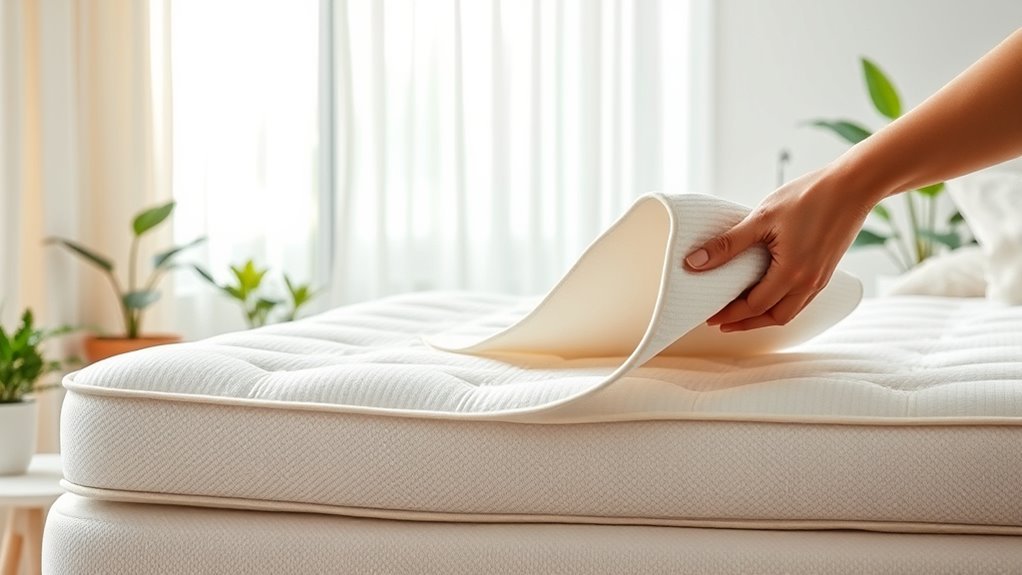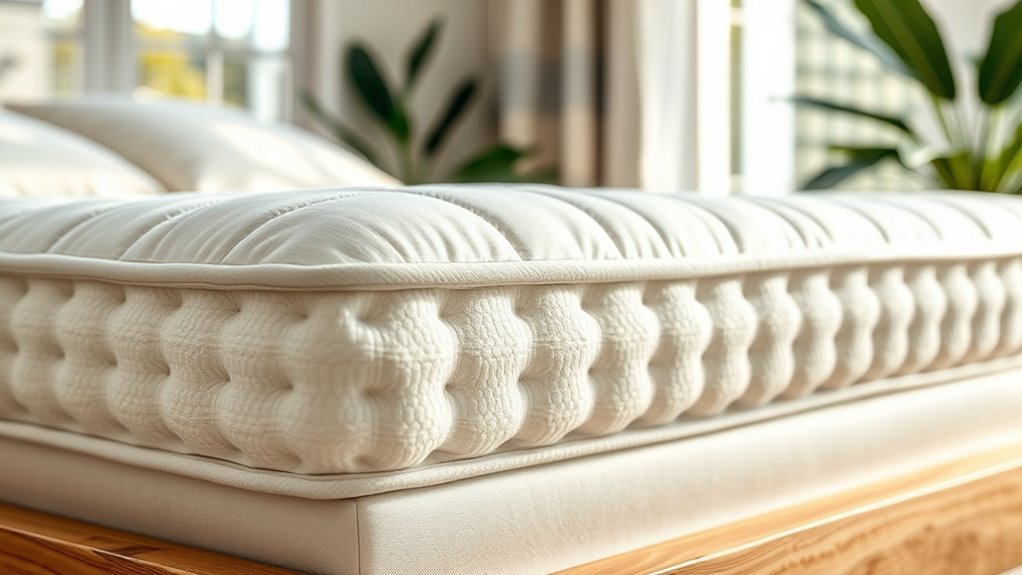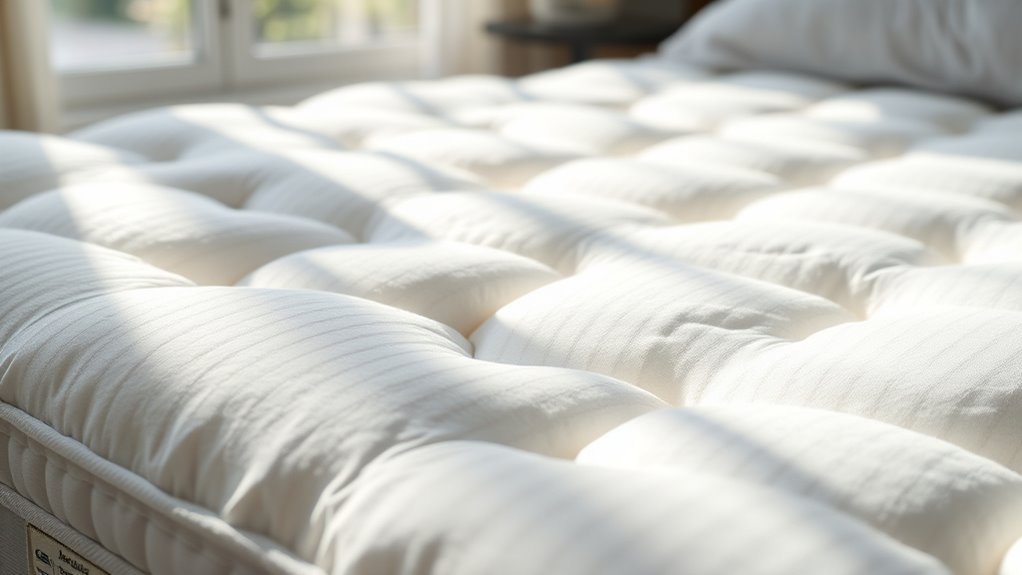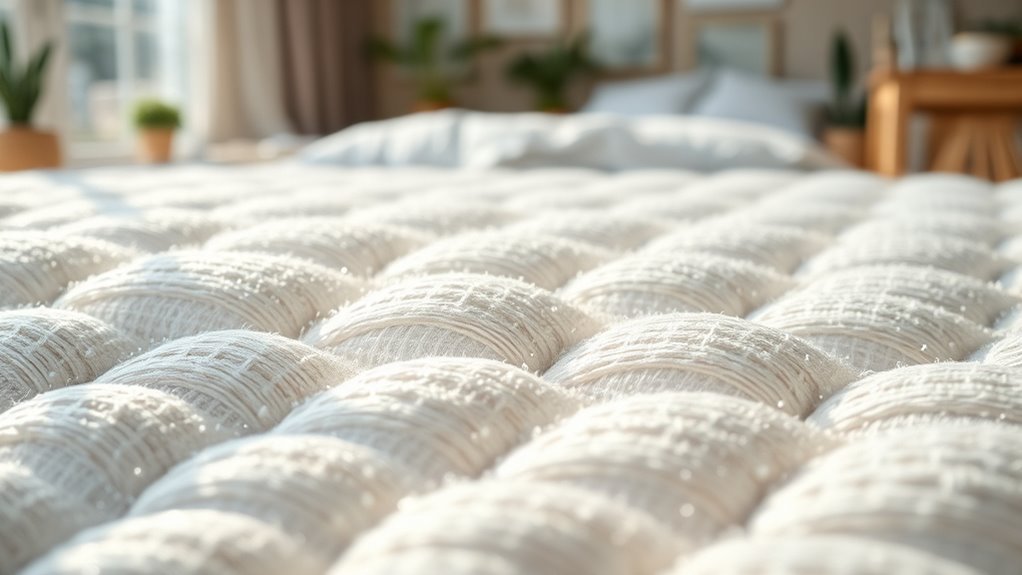To choose a cotton mattress for breathability, look for organic options that promote air circulation and moisture control. Guarantee the construction includes layers designed for airflow, such as a high-quality open cell structure. Also, consider cotton blends or types like Pima or Egyptian cotton for added durability and comfort. Don’t forget to check for certifications indicating chemical-free materials. Making an informed decision can enhance your sleep quality, and there’s more to explore on this topic.
Understanding the Importance of Breathability in Mattresses

When you choose a mattress, understanding breathability is essential because it directly affects your comfort and sleep quality. Breathable materials allow air to circulate, which helps regulate temperature. This is vital for maintaining a comfortable sleep environment, especially if you tend to sleep hot. The breathability benefits of a well-constructed mattress can prevent overheating, allowing you to enjoy uninterrupted sleep. When your body temperature stays regulated, you’re less likely to wake up feeling sticky or restless. Additionally, enhanced airflow reduces moisture buildup, which can lead to mold and allergens. By prioritizing breathability in your mattress selection, you’re investing in a healthier sleep experience that ultimately supports your freedom to rest soundly and wake up refreshed.
Key Features to Look for in a Cotton Mattress

As you explore options for a cotton mattress, it’s vital to focus on key features that enhance both comfort and durability. Look for mattresses made from organic cotton, as they often include sustainability factors that support eco-friendly practices. A durable construction guarantees longevity while maintaining comfort. Hypoallergenic options are also important, especially if you have sensitivities or allergies. These mattresses typically resist dust mites and mold, providing a healthier sleep environment. Additionally, consider the mattress’s firmness level, as it should suit your sleeping position for ideal support. Finally, check for certifications that guarantee the absence of harmful chemicals, making sure you make a safe choice for your home. Prioritizing these features will help you find the perfect cotton mattress.
Types of Cotton Used in Mattresses

While there are various types of cotton used in mattresses, understanding their differences can greatly influence your choice. Here’s a breakdown of the most common types:
| Type of Cotton | Description | Benefits |
|---|---|---|
| Organic Cotton | Grown without synthetic pesticides | Eco-friendly, hypoallergenic |
| Conventional Cotton | Grown with chemical fertilizers | Widely available, cost-effective |
| Cotton Blends | Mixed with materials like polyester | Enhanced durability, varied feel |
| Pima Cotton | High-quality, long-staple fibers | Luxurious feel, breathable |
| Egyptian Cotton | Known for its softness and strength | Premium quality, long-lasting |
Choosing the right type can enhance comfort and breathability, so consider these options carefully as you make your decision.
The Role of Mattress Construction in Breathability
Understanding how mattress construction affects breathability is essential for achieving a comfortable sleep environment. The right design can greatly enhance airflow and temperature regulation. Here are three key factors to take into account:Mattress construction plays a crucial role in breathability, enhancing airflow and temperature regulation for a better sleep experience.
- Cotton Composition: Opt for high-quality cotton to guarantee natural breathability and moisture-wicking properties.
- Mattress Layering: Look for mattresses with multiple layers that include breathable materials, allowing air to circulate freely and prevent heat retention.
- Open Cell Structure: Choose a construction that promotes an open cell structure, which supports better airflow throughout the mattress.
Maintenance Tips for Enhancing Breathability
To maintain the breathability of your cotton mattress, it’s essential to establish a regular cleaning and care routine. Start by using gentle cleaning techniques like vacuuming the surface monthly to remove dust and allergens. Spot-clean any stains with a mild detergent and a damp cloth, ensuring you don’t soak the fabric. For seasonal maintenance, rotate your mattress every three months to promote even wear and airflow. Additionally, consider using a breathable mattress protector to shield against moisture while allowing air circulation. Finally, allow your mattress to air out periodically by removing bedding and letting it rest in a well-ventilated space. These practices will help keep your cotton mattress fresh and enhance its overall breathability.
Comparing Breathable Cotton Mattresses on the Market
When comparing breathable cotton mattresses, you’ll want to contemplate both the construction materials and the brand’s reputation. Different materials can impact breathability, durability, and overall comfort, so it’s crucial to evaluate what each mattress offers. Additionally, a brand’s reputation can provide insights into quality and customer satisfaction, helping you make an informed choice.
Mattress Construction Materials
Choosing the right materials for a breathable cotton mattress can greatly impact your sleep quality and comfort. Here are some key considerations:
- Cotton Quality: Look for organic cotton, which guarantees better breathability and fewer chemicals.
- Foam Type: If your mattress includes foam, opt for natural latex or CertiPUR-US certified foams that offer durability without compromising air circulation.
- Support Layers: Check for sturdy support layers made from sustainable materials to enhance mattress durability factors.
Understanding the cotton sourcing practices is essential, as it influences not only the mattress’s environmental impact but also its overall comfort. Prioritizing these elements will help you choose a mattress that supports your desire for a restful night’s sleep.
Brand Reputation Analysis
Brand reputation plays an essential role in selecting a breathable cotton mattress, as it often reflects the quality and sustainability of the product. When you’re comparing options, look for brands with strong consumer reviews that highlight comfort, durability, and breathability. A reliable brand typically has a history of satisfied customers and consistent product performance. Check for certifications that indicate eco-friendly practices, which can enhance your peace of mind. Additionally, consider how brands respond to customer feedback; proactive engagement often signifies brand reliability. Don’t hesitate to explore third-party reviews and comparisons to get a thorough view. This approach not only empowers you to make an informed choice but also aligns with your desire for freedom in selecting the best mattress for your needs.
Frequently Asked Questions
How Long Does a Cotton Mattress Typically Last?
A cotton mattress typically lasts around 5 to 10 years, depending on its quality and usage. Curiously, studies show that mattresses can lose about 30% of their original support within this timeframe. Cotton’s natural durability contributes to its lifespan, providing both comfort and breathability. However, proper maintenance, like regular cleaning and rotating, can help maximize your mattress lifespan. If you value freedom in sleep, investing in a quality cotton mattress can be worthwhile.
Are Cotton Mattresses Suitable for All Sleep Positions?
Yes, cotton mattresses can be suitable for all sleep positions, depending on your comfort preferences. These mattresses offer a balance of support and softness, which can accommodate back, side, and stomach sleepers. If you prefer a firmer feel, look for options with added support layers. For those who enjoy a plush surface, a thicker cotton layer might be ideal. Ultimately, it’s important to test different mattresses to find the one that feels best for you.
Can I Use a Mattress Protector on a Cotton Mattress?
Absolutely, you can use a mattress protector on a cotton mattress! In fact, it’s like putting a superhero cape on your bed, protecting it from spills and allergens. The benefits of a protector are immense: it makes mattress cleaning a breeze and extends the life of your mattress. Plus, it guarantees you enjoy those heavenly nights without worrying about unexpected accidents. Embrace the freedom of a clean, well-protected sleep sanctuary!
Do Cotton Mattresses Have Any Off-Gassing Odors?
Cotton mattresses typically don’t have significant off-gassing odors, especially since they’re made from natural materials. Unlike synthetic mattresses, which can release volatile organic compounds (VOCs), cotton is less likely to produce off-gassing effects. However, some new mattresses might have a slight smell due to packaging or other components. If you’re sensitive, airing out your mattress for a few days can help eliminate any residual odors, ensuring a fresh sleeping environment.
What Is the Return Policy for Cotton Mattresses?
When it comes to cotton mattresses, think of the return policy as your safety net. Most companies offer a trial period, often around 100 nights, allowing you to test the mattress at home. If it doesn’t suit you, initiating the return process is usually straightforward. Just be sure to check the mattress warranty terms, as some conditions may apply. Don’t hesitate to reach out if you have any questions about the specifics!



